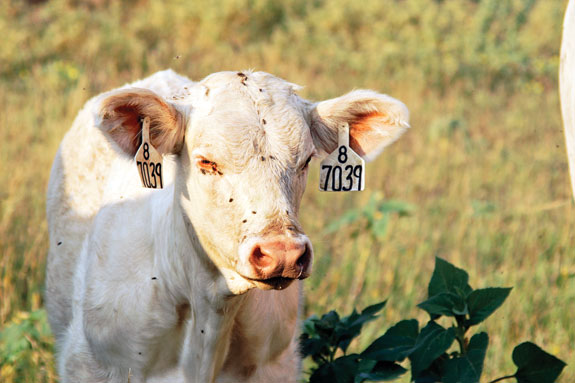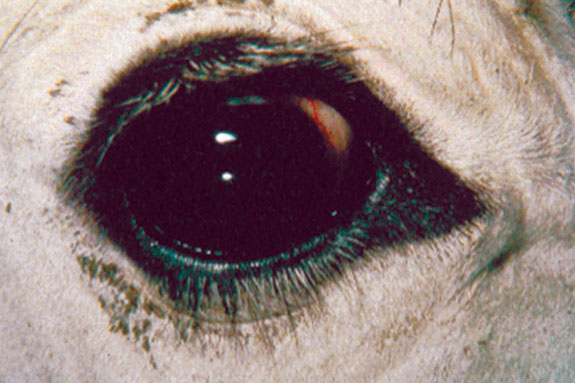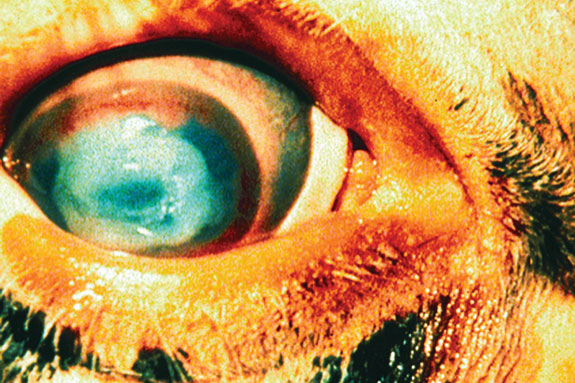A reduction in weaning weights greater than 40 pounds has been reported in affected calves.
Calves with lesions from pinkeye at sale time have posted sale-barn discounts as high as $11.35 per hundredweight.
These losses can be avoided if a complete preventative program is implemented. Preventing pinkeye means addressing all the causes: the bacteria that cause pinkeye (Moraxella Bovis), the flies that cause irritation and spread disease and the environmental irritants that damage the eye.
An effective management program should be viewed like a three-legged stool, in which the absence of any one of three legs can cause the whole program to tip out of balance, resulting in failure.
Prevent the infection
When a pinkeye disease outbreak occurs, bacteria attach to the cornea, or surface, of the eye with fingerlike projections called pili and release toxins that damage the eye.
Excessive tearing is the first sign of a disease outbreak, followed by damage to the cornea. This damage results in corneal ulceration in as little as 24 hours.
Corneal ulcers are extremely painful and can, if left untreated, progress to rupture and loss of the eye.
Therefore, the first leg of the management stool is a preventative vaccination with a broad-spectrum, single-dose, pili-based vaccine for Moraxella bovis.
A good vaccine produces antibodies that are secreted in the tears and bathe the eye. These antibodies act to reduce the number of bacteria present and eliminate or reduce the severity of the disease caused by the invading bacteria.

Research shows there are more than 140 different strains of Moraxella bovis alone. So, immunity needs to be refreshed annually with a broad-spectrum vaccine.
But broad-spectrum doesn’t necessarily mean how many isolates are contained in the vaccine; rather it refers to how broad the protection is in cross-reacting with Moraxella bovis isolates that have been known to cause pinkeye.
Your broad-spectrum vaccine should stimulate protective antibodies in the tears of the eye that cross-react with more than 100 different strains of Moraxella bovis bacteria.
On some occasions, there are other bacteria that may contribute to development of pinkeye. The bacteria Moraxella bovoculli, for example, has been isolated following pinkeye outbreaks in cattle.
Currently, there is no commercially-licensed vaccine available for protection. Upon culturing and isolating this bacterium, your veterinarian may recommend the development of an autogenous vaccine.
It is very important to keep in mind that the use of an autogenous vaccine should be additive to your pinkeye vaccination control program and not replace a broad-spectrum Moraxella bovis vaccine.
Another important note is that autogenous vaccines do not have to prove their effectiveness before use; simply their safety.
It is not known if they protect against other bacteria in the environment. Commercially produced vaccines have shown efficacy against the pathogens they are labeled for and always should be included in your vaccination program.
Adequate nutrition and proper timing of vaccinations are cornerstones to building a good defense against pinkeye.
To this end, vaccinations should be administered five to six weeks prior to the pinkeye season in order for the animal to develop immunity.
Stop the flies
Even a good vaccination program can be overwhelmed if exposure to the disease-causing bacteria gets too high.
Pinkeye problems can spread rapidly due to the pesky contact of flies that transport the bacteria from the eyes of one animal to another. That’s why the second leg of the pinkeye control stool is fly control.
While both horn flies and face flies contribute to pinkeye in cattle, face flies rapidly spread the disease from animal to animal within a herd.
Adult face flies look like common houseflies but are slightly larger and darker in color. Face flies normally are observed swarming around the nostrils, muzzle and eyes of cattle.
They have sharp microscopic teeth, which they use to irritate the eye tissue. Adult face flies, especially females, feed on saliva, nasal mucus, blood and serum oozing from wounds, including bites where blood-sucking flies have previously fed. Female face flies need the protein from these fluids to develop their eggs.
Females lay their eggs in fresh manure where they hatch and larvae develop. With a 15-day to 25-day life cycle, a significant number of generations can develop during the grazing season.
Unlike the horn fly, which stays on the host animal, face flies spend time away from cattle. They can travel significant distances between herds carrying pinkeye bacteria with them, thereby exposing your animals to many different strains of Moraxella bovis.
This is why vaccination with a broad-spectrum pinkeye vaccine and fly control are such critical legs of a pinkeye prevention protocol.

Whether you need to evaluate your current fly control program or start a new one, here are some best management practices to consider, even late in the pinkeye season:
- Treat animals of all ages and their premises with an effective, long-lasting and easy-to-administer insecticide.
- For calves and cows, apply two insecticide ear tags per animal. Be sure your tags hang down from the ear properly as the tags act as small insecticide applicators, releasing product onto the animal’s shoulders and back each time the animal swings its head and ears to swat flies.
- When applying tags, use a low-volume, long-lasting pour-on for rapid knockdown of the existing fly population.
- For premise control, use an insecticide such as a microencapsulated product that delivers superior, long-lasting control on a wide variety of surfaces in and around livestock facilities.
- Use additional fly-control measures as necessary, such as back-rubbers, oilers and other devices that can be used on pasture.
- When ear tags lose their effectiveness, remove them and apply a final dose of a low-volume pour-on.
- If you believe a product is not working, contact the manufacturer and your animal-health provider to discuss the situation and get help.
- Reapply insecticides as necessary throughout the fly season and always follow label directions.

Manage the environment
The third leg in pinkeye management addresses environmental management practices, such as pasture mowing, dust control and man-made or natural shades.
External factors can contribute to an increase in pinkeye prevalence as well. Ultraviolet light, pollen, seed heads and dust can cause eye irritation, which allows infectious pinkeye organisms to attach to the surface of the eye.
These environmental factors can also cause the eye to tear. Tearing, watery eyes can attract flies which feed on the watery exudates from the eye and surrounding tissue.
As earlier discussed, these flies can carry many different strains of pinkeye-causing bacteria. All these factors can contribute to significant increases in the incidence of pinkeye in your cattle.
It is critical to examine all three legs of the pinkeye prevention stool to ensure a successful pinkeye prevention program.
Your local herd veterinarian can assist you in developing a total program for your operation that will provide the highest level of protection. ![]()
Eric Moore is a technical services veterinarian for Merck Animal Health. He lives in Kansas and can be contacted at (785) 410-4113.
PHOTOS
TOP: Adult face flies, especially females, feed on saliva, nasal mucus, blood and serum oozing from wounds.
MIDDLE TOP: Face flies normally are observed swarming around the nostrils, muzzle and eyes of cattle.
MIDDLE BOTTOM: A healthy eye without pinkeye bacteria.
BOTTOM: A cattle’s pinkeye in the second stages of infection. Photos courtesy of Merck Animal Health.









